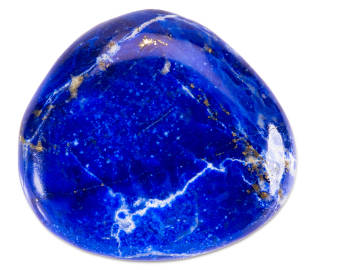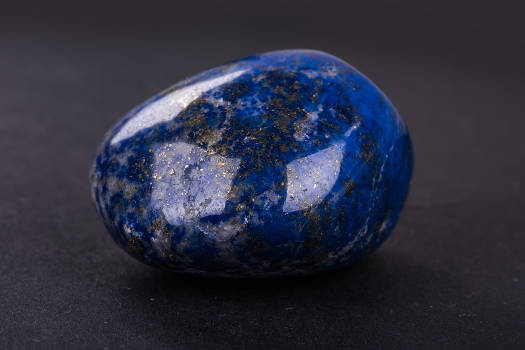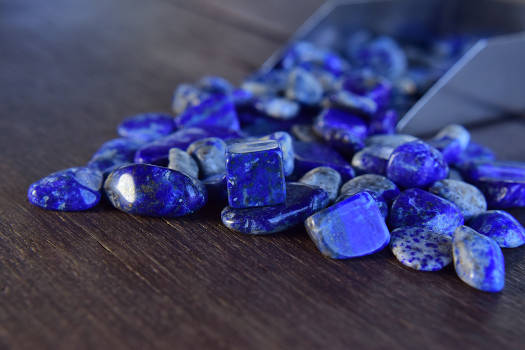Lapis lazuli is historically known as a stone of royalty, prized for ages for its deep blue color and shimmering golden flecks.
For millennia, it was used for everything from creating pigment for illuminated manuscripts and artwork, to cosmetics for the elite.
From kings and queens, to users of folk magic, lapis lazuli has drawn in people from all walks of life.
About Lapis Lazuli
Lapis lazuli is a metamorphic rock comprising lazurite, sodalite, and calcite, among other minerals, with inclusions of metallic pyrite.
Its bright blue color comes courtesy of sulfur ions, which carry a negative charge. As electrons jump from one atomic orbital to another, they can affect the wavelengths of light that an object absorbs.

In lapis lazuli’s case, this causes the stone to very strongly absorb light in the red-orange spectrum. That means that it strongly reflects light in the blue spectrum, resulting in a bright blue stone.
See also: Check out Lapis Lazuli stones here.
Lapis Lazuli Healing Properties & Benefits
In addition to a stone of royalty and nobility, lapis lazuli is considered a stone of truth. Emotionally, it can help users speak their own truth, gain self-awareness, and facilitate acceptance.
It helps bring unresolved issues to the surface, and encourages honesty in all things. This allows the user to experience emotional growth and healing. Some healers use it to relieve symptoms related to depression.
Physically, this stone is used for disorders of the throat and neck, and is said to alleviate problems with the body’s rhythms — from dysfunctional sleeping patterns and insomnia, to circulatory problems, to menstrual issues.
It’s also used to relieve infections and inflammation in a general sense, and alleviate the symptoms of some neurological issues, including headaches. According to some sources, it can help detoxify the blood and organs.
See also: Check out Lapis Lazuli jewelry here.
Lapis Lazuli Magical Properties
As such a valuable and highly prized stone, lapis lazuli has a lot of magical and metaphysical applications. It’s considered a charm to ensure fidelity, strengthen relationships, and draw spiritual love to the user.
For diviners, this gem can help improve intuition and facilitate the detection of subtle energies. It’s said to “disconnect” the logical mind and one’s psychic perception.
Some use this stone for glamours — specific types of spells intended to alter the perception of the user in other people’s eyes and minds. It’s said to be good for increasing one’s charisma.

Others use it for exorcisms. While lapis lazuli is a very protective stone, that protection is strongly tied to its ability to facilitate honesty — it’s best at keeping liars and con artists away and uncovering false friends.
When used in conjunction with other crystals, herbs, or magical tools, it can help cut through the deceptions and illusions inherent in some possessions.
While lapis’ charismatic, intuitive, and truth-seeking properties make it a popular ingredient for gem elixirs, these should only ever be made using an indirect method.
Soaking this stone directly in water can cause it to leach sulfur and lead, which would make any resulting elixir toxic.
For those who work with chakras, lapis lazuli is used to open and unblock the throat chakra, Vishuddha. This can help the user communicate and have the courage to speak their mind, as well as relieve physical ailments related to problems with this energy center.
Lapis Lazuli History & Folklore
In addition to jewelry and carvings, lapis lazuli has been used for construction. Two of the columns in St. Isaac’s Cathedral in Saint Petersburg were made with lapis. Much of the blue in Renaissance artwork was made of ground lapis pigment.
Cleopatra used this powdered stone as a cosmetic.
The name “lapis lazuli” comes from a mixture of Greek, and Persian via Greece. It translates to “stone of the heavens” or “stone of the sky.”
In ancient Persia, lapis was used to create charms against malevolent energy sent by others, like the evil eye.
Up to the Middle Ages, lapis lazuli was called “sapphire.” References to sapphire in old grimoires and alchemical texts refer to lapis, not the sapphire we know today.
How to Cleanse Lapis Lazuli
Lapis’ varied composition makes it a bit of a challenge to cleanse. While it’s a fairly hard stone (at about 5-6 on the Mohs scale) its pyrite and other mineral inclusions mean it doesn’t really play nicely with water or bright sunlight.
To cleanse your stone, try one of the following methods instead.
Some methods for cleansing Lapis Lazuli include:
- Fumigating it with cleansing herbs or incense.
- Playing music, chimes, bells, or singing bowls.
- Setting it in the light of a full moon, preferably on top of a clear quartz or selenite.
- Sprinkling it with sea salt, dried cleansing herbs, or a combination of both.
- Using your personal energy.
Any cleansing method will work to restore this stone to its energetic baseline, but some techniques can cause physical damage. Whichever you choose is fine, even if isn’t on this list, but avoid any that involve water, extremes of temperature, or intense sunlight.
Getting Started With Lapis Lazuli
Lapis lazuli is a fairly abundant stone that’s easy to find in metaphysical shops. As with any crystal, it’s best to know your supplier well, and be sure that they’re sourcing their stones from ethical harvesting operations.
You should make every effort to choose your stone in person. This will let you select the stone that’s not only the most aesthetically appealing to you, but also resonates with your energy.
Pick up a variety of lapis specimens, and see how they feel. Hold them in your non-dominant hand, one at a time, and note what sensations or emotions you experience.
Stones that feel tingly, tickly, or buzzy are good, avoid any that feel prickly, or make you feel oddly sad, anxious, or angry.

Even though lapis is easy to find, it’s still often faked. Even when it isn’t faked deliberately, other, cheaper stones are often sold as lapis. One of the most common of these is sodalite.
While sodalite is often a component of genuine lapis, pure sodalite is very different. It typically has more white inclusions and no pyrite, though this isn’t a hard and fast rule — some lapis and sodalite specimens can look extremely close.
The best test in this case is a basic scratch test. Using a white, unglazed ceramic plate, run a discreet spot on the stone along its surface. Genuine lapis lazuli will leave a blue streak when scratched against the plate. Sodalite will leave a white streak.
When you have your lapis specimen at home, you’ll probably want to cleanse it. You can use any of the methods above, and allow your intuition to guide you. This will remove any extraneous energies from the stone and prepare it to work with you.
After cleansing, you can use your lapis lazuli however you’d like. To protect against psychic attacks or the evil eye, wear it as jewelry. To guard your home against liars, con artists, and sneaky thieves, bury four lapis stones at the corners of your property.
To aid with divination, meditate with one before reading tarot, casting runes, scrying, or throwing bones. For healing, place or wear the lapis on the affected body part.
There’s no other gem quite like lapis. Humans have been captivated by it for thousands of years, and have used it for everything from construction, to carving, to jewelry, to cosmetics, to magical and healing tools.
Your lapis lazuli is a precious and powerful spiritual ally. Use it well.
As an Amazon Associate, Terravara earns from qualifying purchases at no additional cost to readers.
